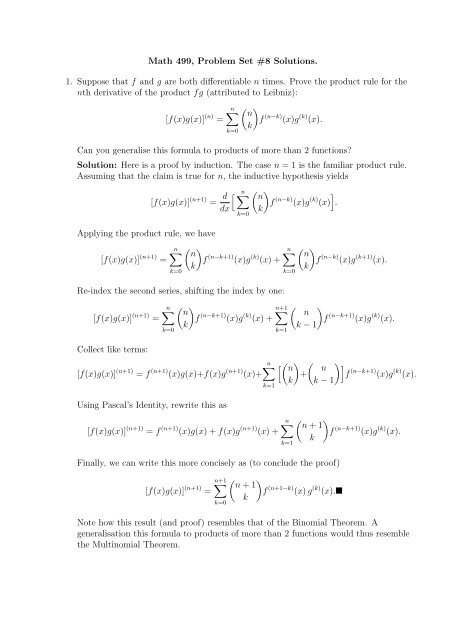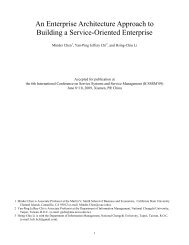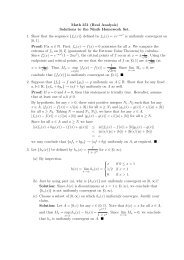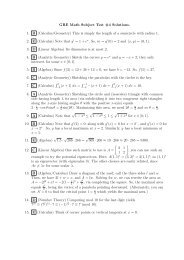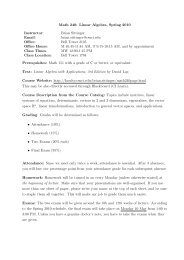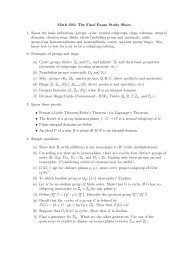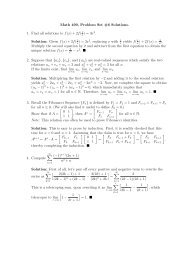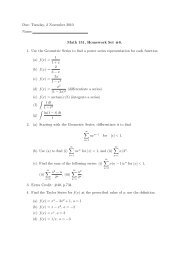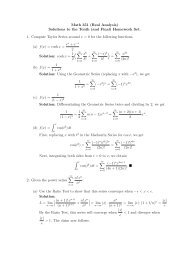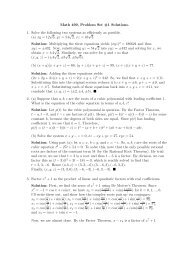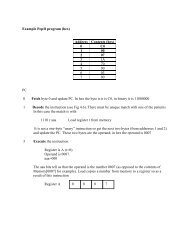Math 499, Problem Set #8 Solutions. 1. Suppose that f and g are ...
Math 499, Problem Set #8 Solutions. 1. Suppose that f and g are ...
Math 499, Problem Set #8 Solutions. 1. Suppose that f and g are ...
You also want an ePaper? Increase the reach of your titles
YUMPU automatically turns print PDFs into web optimized ePapers that Google loves.
<strong>Math</strong> <strong>499</strong>, <strong>Problem</strong> <strong>Set</strong> <strong>#8</strong> <strong>Solutions</strong>.<strong>1.</strong> <strong>Suppose</strong> <strong>that</strong> f <strong>and</strong> g <strong>are</strong> both differentiable n times. Prove the product rule for thenth derivative of the product fg (attributed to Leibniz):[f(x)g(x)] (n) =n∑k=0( nk)f (n−k) (x)g (k) (x).Can you generalise this formula to products of more than 2 functions?Solution: Here is a proof by induction. The case n = 1 is the familiar product rule.Assuming <strong>that</strong> the claim is true for n, the inductive hypothesis yields[f(x)g(x)] (n+1) = ddxApplying the product rule, we have[f(x)g(x)] (n+1) =n∑k=0[ n∑k=0( nk)f (n−k+1) (x)g (k) (x) +Re-index the second series, shifting the index by one:[f(x)g(x)] (n+1) =Collect like terms:k=0( n]fk)(n−k) (x)g (k) (x) .k=1n∑k=0( nk)f (n−k) (x)g (k+1) (x).n∑( n ∑n+1( ) nfk)(n−k+1) (x)g (k) (x) +f (n−k+1) (x)g (k) (x).k − 1[f(x)g(x)] (n+1) = f (n+1) (x)g(x)+f(x)g (n+1) (x)+Using Pascal’s Identity, rewrite this asn∑k=1[f(x)g(x)] (n+1) = f (n+1) (x)g(x) + f(x)g (n+1) (x) +Finally, we can write this more concisely as (to conclude the proof)[ ( ) ( )n n ]+ f (n−k+1) (x)g (k) (x).k k − 1n∑( ) n + 1f (n−k+1) (x)g (k) (x).kk=1∑n+1( ) n + 1[f(x)g(x)] (n+1) =f (n+1−k) (x) g (k) (x).kk=0Note how this result (<strong>and</strong> proof) resembles <strong>that</strong> of the Binomial Theorem. Ageneralisation this formula to products of more than 2 functions would thus resemblethe Multinomial Theorem.
⎡4. If A = ⎢⎣ .1 x 1 x 2 1 · · · x n−111 x 2 x 2 2 · · · x n−12. . . .1 x n x 2 n · · · x n−1n⎤⎥, then det(A) =∏⎦1≤i
5. Fix a, b > 0. Show <strong>that</strong>Solution: Let I =∫ ∞0∫ ∞0e −(ax2 +bx −2) dx = 1 2 e−2√ ab√πa .e −(ax2 +bx −2) dx.By completing the squ<strong>are</strong>, rewrite this as I = e −2√ ab√Now, let y = x −1 b; this transforms the integral toa√I = e −2√ ab ba∫ ∞0∫ ∞0√e −(y√ a− by )2√e −(x√ a− bx )2 dx. (*)dyy 2 .√Upon changing the dummy variable, we have I = e −2√ ab ba∫ ∞0√e −(x√ a− bx )2dxx 2 . (**)Now comes the fun part: multiply both sides of (*) <strong>and</strong> (**) by √ a <strong>and</strong> add theseresults to obtain 2I √ ∫ ∞√√a = e −2√ abe −(x√ a− b)2( √ b)x a + dx.x 2Using the substitution z = x √ a − √ b, the integral simplifies to2I √ a = e −2√ ab∫ ∞−∞0xe −z2 dz = e −2√ ab √ π, by using the Gaussian Integral.Solving for I, we obtain I = 1 2 e−2√ ab√πa .


